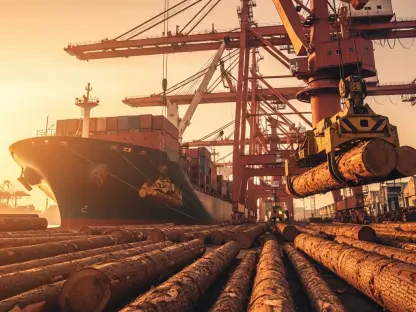In recent years, the intersection of sustainability and technological advancements has been reshaping the paper manufacturing industry, particularly its implications for the laminate sector. With paper and resin constituting essential raw materials in high-pressure laminate production, shifting dynamics in the paper industry can significantly influence the production of laminates. Giovanni Iurza, CEO of Greenlam Decolan, offers invaluable insights into the current state of this sector in Asia, outlining key trends and challenges that are impacting the industry on both a regional and global scale. He emphasizes that kraft and design paper account for nearly 70 percent of the materials used in laminate manufacturing, underscoring how vital these components are to the industry. However, the paper sector is experiencing volatility triggered by disruptions in global trade routes like the Red Sea and the Suez Canal. These disruptions have caused significant delays in supply chains, leading to a ripple effect across various industries, including laminates.
Impact of Economic Growth on Paper Demand
One of the notable emerging trends driving the demand for paper is its versatility coupled with the booming packaging industry, which is fueled by economic growth across various business verticals. Companies are increasingly favoring paper over plastics as a packaging material, not just for its adaptability but also for the growing consumer preference for sustainable products. Moreover, rising disposable incomes have significantly boosted furniture sales, thereby increasing the demand for laminates and, by extension, high-quality paper. High-pressure laminates, often used in furniture and interior design, rely heavily on the availability and quality of kraft and design papers. Thus, the demand for paper in the laminate industry is intricately tied to broader economic trends and consumer behaviors.
However, the growth in demand does not come without its challenges. The quality of kraft paper produced domestically, particularly in countries like India, has faced scrutiny for not meeting the stringent standards required for laminate manufacturing. This discrepancy necessitates substantial improvements in quality control and production processes to meet industry expectations. Consequently, companies are compelled to explore imported options or invest in upgrading local production capabilities. As global supply chains remain volatile owing to geopolitical tensions and trade route disruptions, businesses in the laminate industry must adapt by establishing resilient networks for sourcing raw materials and distributing finished products.
Sustainability Initiatives and Regulatory Compliance
Sustainability has emerged as a pivotal focus in the paper manufacturing sector, with regulatory bodies enforcing stringent guidelines on raw material sourcing and traceability. This increased scrutiny ensures that paper products meet eco-friendly standards, catering to a growing market segment that prioritizes sustainability. Companies are now mandated to adhere to certifications like the Forest Stewardship Council (FSC) and the Program for the Endorsement of Forest Certification (PEFC). These certifications serve as benchmarks for responsible forest management and sustainable production practices, driving the industry towards greater transparency and accountability. As the global community becomes more environmentally conscious, adherence to these certifications not only helps in compliance but also enhances brand reputation and consumer trust.
In pursuit of sustainability, the paper manufacturing industry is actively leveraging modern technologies to innovate and improve production processes. Technologies such as Artificial Intelligence (AI) and the Internet of Things (IoT) are being integrated to automate various aspects of paper production. These advancements help reduce labor dependence and optimize resource utilization, thereby minimizing waste. The use of AI can facilitate predictive maintenance of machinery, ensuring smoother operations and reducing downtime. Additionally, IoT technology allows for real-time monitoring of production parameters, enabling more efficient energy consumption and resource management. Such technological innovations are crucial as companies strive to reduce their carbon footprints and promote the use of renewable energy sources in their production lines.
Future Outlook and Industry Adaptations
In recent years, sustainability and technological advancements have been transforming the paper manufacturing industry, particularly affecting the laminate sector. Paper and resin are crucial raw materials in high-pressure laminate production, so changes in the paper industry significantly impact laminate manufacturing. Giovanni Iurza, CEO of Greenlam Decolan, provides valuable insights into the industry’s current state in Asia, highlighting key trends and challenges affecting both regional and global scales. He notes that kraft and design paper make up nearly 70% of the materials used in laminate production, emphasizing their importance. However, the paper industry is witnessing volatility due to disruptions in global trade routes like the Red Sea and the Suez Canal. These disruptions have caused considerable delays in supply chains, creating a ripple effect across various sectors, including laminates. As the industry navigates through these challenges, companies are seeking more sustainable and efficient ways to mitigate these impacts and ensure steady production.









